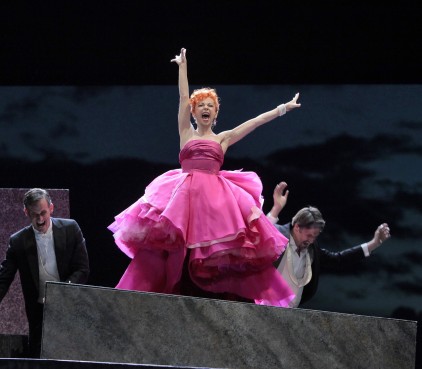Hyperactive Dessay upstages Violetta in soprano’s “Traviata” debut
 SANTA FE: Paul Moravec’s The Letter, commissioned by Santa Fe Opera, is the most newsworthy production of the company’s 53rd season. But for old-fashioned, scenery-chewing divadom, Natalie Dessay’s rambunctious role debut as Violetta in La Traviata is the event drawing aficionados to New Mexico this summer.
SANTA FE: Paul Moravec’s The Letter, commissioned by Santa Fe Opera, is the most newsworthy production of the company’s 53rd season. But for old-fashioned, scenery-chewing divadom, Natalie Dessay’s rambunctious role debut as Violetta in La Traviata is the event drawing aficionados to New Mexico this summer.
Santa Fe Opera’s production of Verdi’s tragic tear-jerker, seen Tuesday night, no doubt served up enough affecting vocalism and dramatic exigency to satisfy Dessay’s many fans. Some will feel that the popular French singer’s high soprano lacks the weight and dramatic cut to do full vocal justice to the role. Yet the current trend is for light-voiced coloratura sopranos to tackle Violetta, and Dessay’s vocal acting and moments of glorious vocalism made up the balance for the lack of cut and volume.
What will separate her fans from the more circumspect is Dessay’s jarringly revisionist take on the tragic courtesan, in a staging that encourages the soprano’s stage excesses at the expense of pushing Violetta and, often, Verdi, into the background.
All operas benefit from dusting off the accumulated cobwebs for a new approach. But this new production appears to offer the worst of both worlds with a relentlessly bleak and depressing scenic design fronted by Dessay’s hyperactive, wildly over-the-top performance.
From her entrance in Act 1 with a delighted shriek at her amorous party revelers, wearing a bright-orange wig and hot-pink ruffled prom dress, we know we’re not in Paris anymore—-at least the familiar elegant salon where the French demi-monde congregate.
Others have retooled the traditional take on Violetta to be sure, but Dessay’s orange-haired party girl is so over the top, even she can’t convincingly make the turn to the tragedy of the later acts. For much of the first two acts, Dessay indulges her overcaffeinated gamin shtick so much—running, jumping, crawling on all fours (during Sempre libera), lying in a heap on the stage, or leaping about on the set’s irregular blocks—-that it’s hard to abruptly switch from annoying floozy to devastated, transfigured tragic figure. In Act 1 when the soprano repeatedly flings her arms wide for high notes, you half expect Dessay to break into I enjoy being a girl.
That’s not to say that there weren’t moments of the affecting vocalism and dramatic insight one would expect from one of the finest actresses in opera today. One will rarely hear Ah fors’e lui rendered with such glowing inner feeling, or her attentive word-painting throughout, with the familiar texts often freshly illuminated.
Dessay was decidedly underpowered in the final act yet the radiance and intimacy of her singing made up the balance. Still, dramatically, there was a sense of overall calculation that made one acutely aware we were experiencing a “Dessay performance” rather than a Verdi opera.
In Saimir Pirgu, the soprano had a similarly vocally slender partner. The Albanian tenor was an efficient rather than inspired Alfredo in the first acts with an anodyne Brindisi, though he proved more forceful in the confrontation at Flora’s and delivered a gorgeously floated Parigi, o cara with Dessay in the final act.
 The most satisfying all-around performance came from Dessay’s husband, Laurent Naouri, as Germont. Dignified of bearing, with an ideal middleweight baritone, Naouri was fatherly yet compassionate and his memorable Di Provenza was a highlight of the evening.
The most satisfying all-around performance came from Dessay’s husband, Laurent Naouri, as Germont. Dignified of bearing, with an ideal middleweight baritone, Naouri was fatherly yet compassionate and his memorable Di Provenza was a highlight of the evening.
Chantal Thomas’s gray-green unit set consisted of a series of irregularly-sized blocks on which the characters and chorus stand or move about. In Act 2 the vying parallelograms were enhanced by a large curved hedgerow of yellow-green mulch meant to depict the couple’s rustic milieu—a candidate for my top ten least attractive sets of all time.
Promoting a costume designer to stage director is almost never a good idea, A few of Laurent Pelly’s ideas were intriguing, like having the female chorus members change Dessay’s costume onstage during the Prelude to Act 3. Otherwise, Pelly’s conceptions were alternately indulgent or just strange. In addition to failing to rein in his star soprano’s scenery mastication, other weirdness was Dessay’s Equus-like stable boy outfit for the first scene of Act 2, and in the same act’s tragic coda, having the chorus members suddenly break into a waltz.
Conductor Frederic Chaslin led an uncommonly refined performance, but one that was tasteful to a fault, far too circumspect when more dramatic weight and impact was needed.
Verdi’s La Traviata rus through August 29. www.santafeopera.org; 505-986-5900, 800-280-4654.
Posted in Performances
2 Responses to “Hyperactive Dessay upstages Violetta in soprano’s “Traviata” debut”
Leave a Comment
Fri Aug 7, 2009
at 10:45 pm
2 Comments

Posted Aug 08, 2009 at 4:54 pm by William
I can imagine that Dessay is over the top as Violetta as you say. She seems wired and hyper in everything she does even when interviewing people backstage at the Met during the HD transmissions. These types of people (like Robin Williams) make me nervous, and I can not stand to be around them, so I am glad I did not go to this Traviata. I almost did, b/c my aunt lives in New Mexico. La Traviata is one of my favorite operas, and Violetta with bright orange hair and hot pink dress turns her into a vulgar and garish character. What beautiful woman in the entire world in any time period would show up to a party like that?????
I also think great singers can stand stock still and steal the entire show without jumping around and screaming and acting crazy. I witnessed Lorraine Hunt (later adding Lieberson) sing Ottavia in Poppea and she stood still and sang her final scene “Addio, Roma” in a way that your heart broke for her, and she did nothing but walk slowly off the stage as she sang. To me that was true art. She took everyone’s breath away hardly moving at all. The world lost a true artiste when she died.
Dessay uses a lot of antics to “dazzle” people and then people think they’ve seen something great when it was just smoke and mirrors. I feel the same way about Mattila’s Salome. Mattila did high kicks and yoga moves and stripping nude to hide the fact that she is not a true Salome. But that is my opinion. I wish these “antics” would stop and true singing would start!!!
Posted Aug 09, 2009 at 2:05 pm by Dave R.
I think the problem with Dessay is that she does the same thing all the time, no matter what the role. She calls it acting and seems to look down upon those who don’t do what she does, but is it really acting when she’s acting the same way all the time? She’s one of those singers who I like listening to more than seeing.